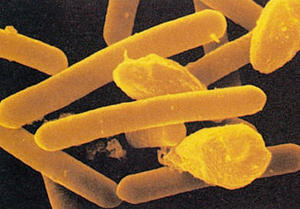BioterrorismDiscovery points way to treatment of lethal toxin botulism
Botulinum neurotoxins are produced by Clostridium botulinum and cause the possibly fatal disease botulism, which impedes nerve cells’ ability to communicate with muscles and can lead to paralysis and respiratory failure. The botulinum toxin has also been identified as a potential biological weapon against a civilian population. Scientists have decoded a key molecular gateway for the toxin that causes botulism, pointing the way to treatments that can keep the food-borne poison out of the bloodstream.

C. botulinum, source of the botulinim toxin // Source: vt.edu
U.S. and German scientists have decoded a key molecular gateway for the toxin that causes botulism, pointing the way to treatments that can keep the food-borne poison out of the bloodstream.
Study leaders Rongsheng Jin, associate professor of physiology & biophysics at UC Irvine, and Andreas Rummel of the Institute for Toxicology at Germany’s Hannover Medical School created a three-dimensional crystal model of a complex protein compound in the botulinum neurotoxin.
This compound binds to the inner lining of the small intestine and allows passage of the toxin into the bloodstream.
A UC Irvine release reports that the 3-D structure — shaped much like the Apollo lunar landing module — lets the researchers identify places on the surface of the complex protein that enable it to dock with carbohydrates located on the small intestine’s interior wall. In tests on mice, they found that certain inhibitor molecules blocked the botulism compound from connecting to these sites, which prevented the toxin from entering the bloodstream.
Botulinum neurotoxins are produced by Clostridium botulinum and cause the possibly fatal disease botulism, which impedes nerve cells’ ability to communicate with muscles and can lead to paralysis and respiratory failure. The botulinum toxin has also been identified as a potential biological weapon against a civilian population.
“Currently, there is no efficient countermeasure for this toxin in case of a large outbreak of botulism,” Jin said. “Our discovery provides a vital first step toward a pharmaceutical intervention at an early point that can limit the toxin’s fatal attack on the human body.”
Study results appear online in the journal PLOS Pathogens.
Jin added that his work opens the door to further development of preventive treatments for botulism. At the same time, the molecular gateway for the lethal toxin could be exploited for alternative applications, such as the oral delivery of protein-based therapeutics.
The research was supported in part by the National Institute of Allergy & Infectious Diseases, the German Research Foundation, the Swiss Federal Office for Civil Protection, and the U.S. Department of Agriculture CRIS project.
— Read more in Kwangkook Lee et al., “Structure of a Bimodular Botulinum Neurotoxin Complex Provides Insights into Its Oral Toxicity,” PLOS Pathogens 9, no. 10 (10 October 2013): e1003690 (doi:10.1371/journal.ppat.1003690)
